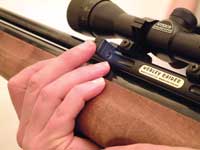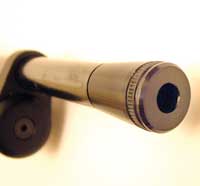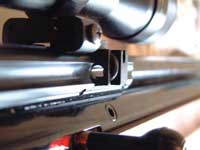Webley Raider air rifle review
by David Hume
Australian Shooter February 2002
When the Australian Shooter reviewed air rifles back in March 2000, I was most impressed by the design of the competition air rifles, which take their power from a pre-charged air cylinder under the barrel. At the time, I thought that it was a shame that this idea was not used in more air rifles, which in the main rely on break barrels and sliding pistons. No moving piston means virtually no recoil and it seemed unnecessary to me that an air rifle with just a fraction of the energy of a .22 rimfire should recoil like a .223. Not because it is uncomfortable, but because there should be a better and a more accurate way of organising things. Hence, an advertisement for the new Webley Raider caught my eye and a call to the distributors, Alcock and Pierce, secured an example in .22 cal for review.
 A bit of background is probably useful here. The rifle is designed and built in Britain and made for a market with firearms regulations different from those here in Australia. In Britain, air rifles have differing licence requirements depending on their energy and those below 12ft-lb may be had without a licence. Most air rifles in Britain are manufactured to have an energy just a whisker under 12ft-lb to meet this requirement but higher energy variants, typically 20ft-lb, are also made. These distinctions are lost in Australia, where an A Class licence is required for any air rifle and usually only the higher-powered models are imported.
A bit of background is probably useful here. The rifle is designed and built in Britain and made for a market with firearms regulations different from those here in Australia. In Britain, air rifles have differing licence requirements depending on their energy and those below 12ft-lb may be had without a licence. Most air rifles in Britain are manufactured to have an energy just a whisker under 12ft-lb to meet this requirement but higher energy variants, typically 20ft-lb, are also made. These distinctions are lost in Australia, where an A Class licence is required for any air rifle and usually only the higher-powered models are imported.
In Australia this rifle comes up against a .22 in a way that it does not in its country of origin, where the Firearms Certificate needed to own a .22 is rather hard to come by. My most common thought during the time I spent with the rifle was, ‘Now, wouldn’t a .22 be a more practical solution?’ but this is not the point. It is a bit like a US magazine pondering, ‘Hey, wouldn’t those Aussies be better off using a semi-auto on pigs?’ The realities of firearms regulations have dictated otherwise.
The Webley Raider retails for $1100 (including GST) and one really needs to buy a pump to charge it and that costs another $400. These prices are reflective of our dollar’s position against the pound and in England its purchase is relatively easier. So, given that the cost of the pump alone will get you a decent .22 bolt action or 5000 rounds to put in one, what do Messrs Webley and Scott give you for your money?
My first impressions as I took the rifle out of the box were good; its high quality is immediately obvious. It is certainly heavy, weighing 7.2lb (3.3kg) unscoped. In looks, feel and finish, it reminded me of the Beeman SLR-98 that we reviewed this past year and the fact that the Webley costs half as much as the Beeman had it looking even better, as far as I was concerned.
I think ‘stubby’ is the best adjective to describe it. Because it is not a break barrel, the 17.5" barrel begins above the trigger and ends just a little ahead of where you might be looking for a break barrel to start. The end of the barrel is threaded for a silencer, again highlighting the different regulations in Britain, with a muzzle cap covering the thread under normal circumstances.


 Overall length is 37". It has a very nice walnut
stock with ambidextrous cheek pieces. The gas cylinder sits under the
barrel and the cylinder tube also contains the filler valve, trigger and
loading mechanism. There are 95 separate parts to the rifle, including
15 O-rings. There are no iron sights, instead it has a ¾" rail for scope
mounting. The maximum pressure in the air cylinder is 200bar or 3000psi,
which should be good for about 40 shots in .22 cal before the pressure
drops too much. The air is introduced into the cylinder using a high-pressure
source, such as a scuba diver’s bottle or the Webley Ezy Pump. Despite
the pump’s name, the only easy way of squeezing air at 3000psi into the
cylinder is to get someone else to do it.
Overall length is 37". It has a very nice walnut
stock with ambidextrous cheek pieces. The gas cylinder sits under the
barrel and the cylinder tube also contains the filler valve, trigger and
loading mechanism. There are 95 separate parts to the rifle, including
15 O-rings. There are no iron sights, instead it has a ¾" rail for scope
mounting. The maximum pressure in the air cylinder is 200bar or 3000psi,
which should be good for about 40 shots in .22 cal before the pressure
drops too much. The air is introduced into the cylinder using a high-pressure
source, such as a scuba diver’s bottle or the Webley Ezy Pump. Despite
the pump’s name, the only easy way of squeezing air at 3000psi into the
cylinder is to get someone else to do it.
To be fair though, after the initial fill, which took about 300 strokes and a few rests along the way, bringing the cylinder back up to pressure after shooting is relatively painless. A rule of thumb is that 50 shots will lower the pressure from 200 to 150bar and 100 strokes of the pump will bring it up again. Air enters the cylinder through a filler probe that uses two O-rings to seal inside a hole in the front cylinder plug. No cover is provided for the filler hole, which needs one if the rifle is intended for use anywhere near dirt or dust.
The rifle has a bolt action with a two-shot magazine. The magazine is a metal slide with two holes drilled for the pellets and it shuttles from side to side aided by a rubber O-ring. Pulling the bolt back will cock the trigger and moving it forward pushes a pellet into the barrel. Locking the bolt back in its rearward position disconnects the trigger. Working the bolt again after firing re-cocks the trigger and slides the second pellet into the barrel, as the O-ring has pulled the magazine across so that the second chamber is in line with the barrel. It is a difficult process to describe in words, the owner’s manual devoting nearly a page to it, but it make sense once you have done it a couple of times.
The magazine allows a rapid second follow-up shot before any more pellets need to be loaded. The downside of this is that it is very easy to pop two pellets in on top of each other and there is no way to get them out except from the business end of the barrel. I fired two pellets at once a few times and it did not bother the gun, but it not help accuracy either.
My only serious criticism of the Raider concerns pellet loading and safety issues associated with it. On picking the gun up, there is no way to tell if there is a pellet in it or not. There is no way of looking inside to inspect the barrel. I am used to assuming that every firearm is loaded until I have assured myself of the contrary by inspection and with the Raider this cannot be done. The manual states, ‘It is recommended to fire the rifle twice at a safe target to eliminate such a possibility’, but this is hardly satisfactory, considering all the occasions a firearm should be checked to make sure it is safe.
The rifle’s handling characteristics are determined mainly by its large mass and short length. Rotational inertia is less than the weight of the gun would suggest and, although it’s heavy, it snaps around pretty well. The stock has a tapered fore-end, with finger grooves that make it easy and comfortable to hold. A two-handed carry seems to suit it best and it comes easily to the shoulder from this position. There is no escaping the fact that it is a lot of gun to lug around the field and some good quality mounts and a broad sling would not go astray.
The test rifle came fitted with a very nice Nykron 1.5 to 4.5x32 scope, which retails for $199. The objective focuses down to ten metres, which is useful for an air rifle and I did my initial sighting in at 15 metres. The gun goes off with quite a crack, sounding more like a .22 than an air rifle. At first it sprayed its pellets all over the place, but soon settled down and after about 50 shots I managed five shots in one ragged hole.
Moving the target out to 25m meant groups of about 2cm. It is an accurate rifle and very satisfying to shoot. The minimal recoil means there is hardly any movement on firing, so with the scope set at 4.5x and a target at 25m, when you pull the trigger you’re looking at the hole you just made in the target. It’s great for instant feedback, enabling you to isolate fliers, shooter error and get a feel for how the breeze is blowing the pellets around.
The trigger was set too firm for my liking, but this is quite easily adjusted once the action is removed from the stock. This rifle inspires confidence that a shot will end up where you aim it. It also packs a fair punch, with a claimed 800fps in .22 cal or 1000fps in .177 cal.
To test penetration, I fired a round-nosed pellet into some bars of soap. At 25m, the pellet penetrated two bars and lodged in the third. Someone intending to use the rifle for pest control could be confident that its combination of power and accuracy would get the job done humanely.
To sum up, it is a high quality, powerful and accurate air rifle.
